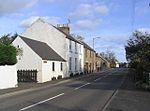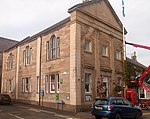Carham Hall

Carham Hall is a grade II listed building near Carham in Northumberland, England. The site, on the Scottish border, was previously occupied by a medieval tower house, built as a defence from border reivers. The Compton family purchased the estate in 1754 and the following year erected the first Carham Hall, a relatively plain building in the Classical style. The hall passed to the Hodgson family and in 1870 Richard Hodgson-Huntley ordered it be rebuilt on a grander scale, in four bays. The hall and estate were afterwards owned by the Perkins family, a daughter of which, Nancy, married William Matthew Burrell in 1903. Nancy Burrell commissioned Scottish architect James Bow Dunn to extend the hall in 1920. This extension added a further four bays to the western end of the structure, creating a larger, linear building. The house was later owned by Sir Thomas Straker-Smith. Carham Hall was granted protection as a listed building at some point in the 20th century but lost this in 1988. The building was in use as a care home by 2011 but this closed in February 2020. Carham Hall is now owned by Henry Straker-Smith who proposed to demolish it in 2021 and erect a modern house. After protests from The Victorian Society the building regained statutory protection as a grade II listed building, saving it from demolition.
Excerpt from the Wikipedia article Carham Hall (License: CC BY-SA 3.0, Authors, Images).Carham Hall
B6350,
Geographical coordinates (GPS) Address Nearby Places Show on map
Geographical coordinates (GPS)
| Latitude | Longitude |
|---|---|
| N 55.642222222222 ° | E -2.3138888888889 ° |
Address
Carham Hall
B6350
TD12 4RP
England, United Kingdom
Open on Google Maps







